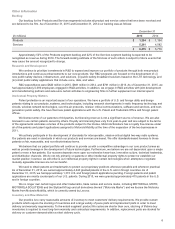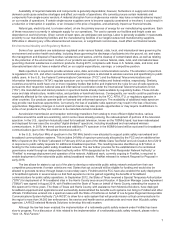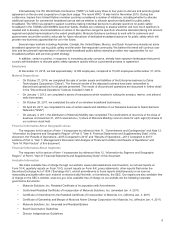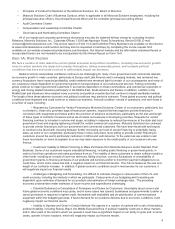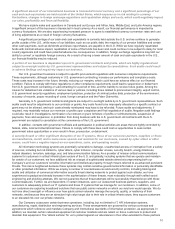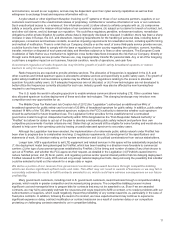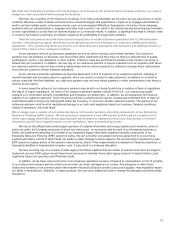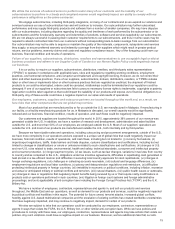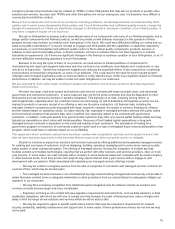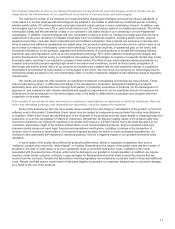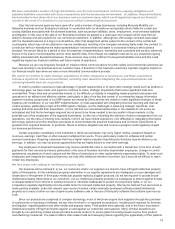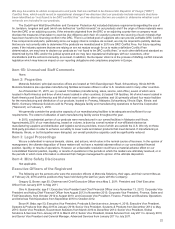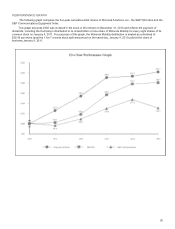Motorola 2015 Annual Report Download - page 17
Download and view the complete annual report
Please find page 17 of the 2015 Motorola annual report below. You can navigate through the pages in the report by either clicking on the pages listed below, or by using the keyword search tool below to find specific information within the annual report.16
corruption policies and procedures may be violated by TPSRs or other third-parties that help sell our products or provide other
solutions and services, because such TPSRs and other third parties are not our employees, and, it is therefore more difficult to
oversee [and control] their conduct.
Many of our components and some of our products, including software, are developed and/or manufactured by third-
parties and in some cases designed by third-parties and if such third-parties lack sufficient quality control, change the
design of components or if there are significant changes in the financial or business condition of such third-parties, it
may have a negative impact on our business.
We rely on third-parties to develop and/or manufacture many of our components and some of our finished products, and to
design certain components and finished products, as well as provide us with software necessary for the operation of those
products and we may increase our reliance such third-parties in the future. We could have difficulties fulfilling our orders and our
sales and profits could decline if: (i) we are not able to engage such third-parties with the capabilities or capacities required by
our business, (ii) such third-parties lack sufficient quality control or fail to deliver quality components, products, services or
software on time and at reasonable prices, or deliver products, services or software that do not meet regulatory or industry
standards or requirements, (iii) if there are significant changes in the financial or business condition of such third-parties, or (iv) if
we have difficulties transitioning operations to such third-parties.
Because of the long life-cycle of many of our products, we need access to limited quantities of components for
manufacturing and repair and suppliers have been and may continue to be unwilling to manufacture such components or may
only do so at high prices. Certain key component suppliers are reducing the expected lifetime of key components, in particular
semiconductor and electrical components, on some of our products. This could result in the need for more frequent product
redesigns and increased engineering costs on some products or costly last time buys, which may negatively impact our financial
performance. In addition, we may be unable to meet our repair obligations to our customers.
We are exposed to risks under large, multi-year system and solutions and services contracts that may negatively
impact our business.
We enter into large, multi-year system and solutions and services contracts with large municipal, state, and nationwide
government and commercial customers. In some cases we may not be the prime contractor and may be dependent on other
third-parties such as commercial carriers or systems integrators. This exposes us to risks, including among others: (i)
technological risks, especially when the contracts involve new technology, (ii) risk of defaults by third-parties on whom we are
relying for products or services as part of our offering or who are the prime contractors, (iii) financial risks, including the
estimates inherent in projecting costs associated with large, long-term contracts, the impact of currency fluctuations, inflation,
and the related impact on operating results, (iv) cyber security risk, especially in managed services contracts with public safety
and commercial customers that process data, and (v) political risk, especially related to the contracts with government
customers. In addition, multi-year awards from governmental customers may often only receive partial funding initially and may
typically be cancelable on short notice with limited penalties. Recovery of front loaded capital expenditures in long-term
managed services contracts is dependent on the continued viability of such customers. The termination of funding for a
government program or insolvency of commercial customer could result in a loss of anticipated future revenue attributable to that
program, which could have an adverse impact on our profitability.
The expansion of our solutions and services business creates new competitors and new and increased areas of risk
that we have not been exposed to in the past and that we may not be able to properly assess or mitigate.
We plan to continue to expand our solutions and services business by offering additional and expanded managed services
for existing and new types of customers, such as designing, building, operating, managing and in some cases owning a public-
safety system or other commercial system. The offering of managed services involves the integration of multiple services,
multiple vendors and multiple technologies, requiring that we partner with other solutions and services providers, often on multi-
year projects. In some cases, we must compete with a company in some business areas and cooperate with the same company
in other business areas. From time to time such projects may require that we form a joint venture with or engage in joint
development with our partners. Risks associated with expanding our managed services offerings include:
• We may be unable to recognize revenue from the sale of equipment in connection with managed services contracts for
a period of time, which may be several years.
• The managed services business is one characterized by large subcontracting arrangements and we may not be able to
obtain favorable contract terms or adequate indemnities or other protections from our subcontractors to adequately mitigate our
exposure to our customers.
• We may face increasing competition from traditional system integrators and the defense industry as solutions and
services contracts become larger and more complicated.
• Expansion will bring us into contact with new regulatory requirements and restrictions, such as data residency or data
localization obligations, with which we will have to comply and may increase the costs of doing business, reduce margins and
delay or limit the range of new solutions and services which we will be able to offer.
• We may be required to agree to specific performance metrics that meet the customer's requirements for network
security, availability, reliability, maintenance and support and, in some cases, if these performance metrics are not met we may
not be paid.


